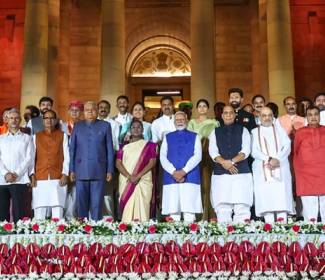On a global stage, India is being hailed as an upcoming economic superpower attributable to the nation’s flourishing information and communication technology sector that contributes ~13% to the national GDP. In FY 2022, the ICT sector registered an impressive revenue of ~$227 Bn, marking ~15% year-on-year growth, the highest since FY 2011. Forecasts indicate an upcoming monumental growth to ~$1 Tr, or ~20% of GDP by 2025. This trajectory underscores India’s ascent as a pivotal player in the global digital landscape. Notably, India also boasts the highest, 87%, FinTech adoption rate globally, surpassing the global average rate of 64%, and is the second-largest mobile market.
India’s information and communication technology sector is indeed booming. The success is hard-earned via deploying multiple government initiatives and overcoming numerous challenges, including the development of adequate digital infrastructure, bolstering policy, legal and regulatory framework, enhancing rural connectivity with ‘broadband for all,’ digital literacy, ensuring data security, sustainable innovation, and fostering public-private partnerships.
Shedding Light on the Winning Transformative Government Initiatives to accelerate ICT
The Digital India Program, launched in 2015, marked a pivotal moment in India’s journey towards digitalisation. The policy focused on accomplishing three vision areas: infrastructure as a utility to every citizen, governance and services on demand, and digital empowerment via 9 ‘pillars’ or focus areas. Encompassing objectives such as e-governance, skill development, and mobile/broadband connectivity, these nine pillars were supplemented by numerous initiatives, including Digi Locker, PMJDY, PAHAL, and the development of smart cities. Today, the government registers substantial progress in each of the vision areas. Hon’ble Prime Minister Narendra Modi approved the expansion of the Digital India program with a total outlay of INR 14903 Cr.
National Policy on Electronics, launched in 2019, establishes a strategic framework for India’s Electronic System Design and Manufacturing (ESDM) sector. Envisioning India as the global leader for ESDM, the NPE 2019 strives to enable domestic electronic manufacturing to achieve a ~$400 Mn turnover by 2025. The policy actively promotes a comprehensive startup ecosystem, particularly in emerging technology areas, including artificial intelligence, 5G, IoT, machine learning, robotics, optics, and more. It underscores the implication of these technologies in key sectors like defence, agriculture, health, cybersecurity, and automation, explicitly addressing real-life challenges. To support the vision, the Indian government allocated $7 Bn in incentives for electronics manufacturing, $10 Bn for a semiconductor and display ecosystem, and $13 Bn for allied sectors, including advanced chemistry cells, auto components, telecoms and networking, and solar modules.
The National Broadband Mission, launched in December 2019, pledges ‘broadband for all’. Given the demographics and the socioeconomic dimensions of a country like India, affordable and reliable digital communications infrastructure is intrinsic to promoting inclusivity and digital empowerment. Thus, with an investment of $35 Bn for telecom towers, $30 Bn for optical fibre infrastructure, and $35 Bn for spectrum/R&D, the Government of India announced the National Broadband Mission to enhance digital communication infrastructure and tap the farthest corners of the country. Worth noting is that the policy strives to roll out 5G services and strengthen the existing 4G network by identifying gaps while promoting “Make in India.”
In addition to the abovementioned policies, the government announced the Data Center Policy in 2020. Given the paradigm shift towards digitalisation, India's data centre market has reached over $7 Bn, growing at 10% from 2019-2022 with a total capacity of 722 MW (doubled in the last 3 years). The data centre capacity is expected to reach 1300 MW by 2025. The policy envisions transforming India into the leading global data centre hub. It seeks to stimulate domestic and foreign direct investments in the sector, propelling the growth of the digital economy. The policy strives to provide trusted hosting infrastructure to meet the country's growing demand for data services while facilitating cutting-edge service delivery to citizens through these reforms: promoting research and development, using indigenous hardware, setting up Data Center Economic Zones (DCEZ), and encouraging renewable energy adoption to power data centres through collaboration with the Ministry of Power on green and sustainable energy initiatives.
As a consequence of unparalleled sustainable digital transformation efforts by the government, the Indian ICT sector is gaining prominence as an attractive destination for domestic and foreign direct investments alike.
WAIPA World Investment Conference: Spotlight on India's ICT advancements and FDI Opportunities
The World Association of Investment Promotion Agencies (WAIPA), established in 1995 under the advocacy of the United Nations Conference on Trade and Development (UNCTAD) and 50 other Investment Promotion Agencies (IPAs), unites 134 IPAs from 110 countries. Alongside multilateral organisations, government officials, business leaders, and other stakeholders from worldwide, WAIPA provides a platform to foster fruitful discussions, engagement, and exchange of expertise. Since its inception in 1995, WAIPA has been organising WIC to address the ongoing socio-economic agendas concerning global investment flows, emerging technologies, and other strategic and policy considerations.
The WAIPA World Investment Conference (WIC) is, thus, a cardinal platform for showcasing India’s unprecedented efforts in activating the information and communication technology sector and attracting foreign direct investments. Supported by conducive government policies and growing ICT demand across industries, the ICT sector is emerging as a lucrative opportunity for foreign investors seeking to capitalise on the sector’s substantial growth in revenue, workforce, and innovation.
Register to learn more on the investible projects available in ~10 countries at the presentation on “Investments in ICT/Technology” sector at #WIC27: https://waipa.org/wic-register/
- https://digitalindia.gov.in/
- https://www.trade.gov/country-commercial-guides/india-information-and-communication-technology
- https://nasscom.in/knowledge-center/publications/technology-sector-india-2022-strategic-review
- https://www.investindia.gov.in/sector/bfsi-fintech-financial-services
- https://www.investindia.gov.in/sector/telecom
- https://www2.deloitte.com/content/dam/Deloitte/in/Documents/technology-media-telecommunications/in-tmt-digital-india-unlock-opportunity-noexp.pdf
- https://www.meity.gov.in/writereaddata/files/Notification_NPE2019_dated25.02.2019.pdf
- https://www.meity.gov.in/writereaddata/files/Notification_NPE2019_dated25.02.2019.pdf
- https://www.trade.gov/country-commercial-guides/india-information-and-communication-technology
- https://www.jll.co.in/en/newsroom/india-data-centre-industry
- https://www.meity.gov.in/writereaddata/files/Draft%20Data%20Centre%20Policy%20-%2003112020_v5.5.pdf
- https://www.trade.gov/country-commercial-guides/india-information-and-communication-technology
- https://www2.deloitte.com/content/dam/Deloitte/in/Documents/technology-media-telecommunications/in-tmt-digital-india-unlock-opportunity-noexp.pdf
- https://www.meity.gov.in/writereaddata/files/Draft%20Data%20Centre%20Policy%20-%2003112020_v5.5.pdf
- https://www.meity.gov.in/writereaddata/files/Notification_NPE2019_dated25.02.2019.pdf
- https://www.investindia.gov.in/team-india-news/union-cabinet-approves-expansion-digital-india-programme-outlay-inr-14903-cr#:~:text=August%2017%2C%202023-,Union%20Cabinet%20approves%20expansion%20of%20the%20Digital%20India%20programme,outlay%20of%20INR%2014%2C903%20Cr&text=Prime%20Minister%20Shri%20Narendra%20Modi,outlay%20is%20INR%2014%2C903%20Cr
- https://www.investindia.gov.in/team-india-blogs/waipa-empowering-ipas-drive-global-economic-growth






